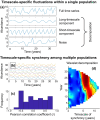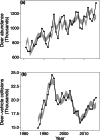Insights Into Spatial Synchrony Enabled by Long-Term Data
- PMID: 40269596
- PMCID: PMC12018873
- DOI: 10.1111/ele.70112
Insights Into Spatial Synchrony Enabled by Long-Term Data
Abstract
Spatial synchrony, the tendency for temporal fluctuations in an ecological variable to be positively associated in different locations, is a widespread and important phenomenon in ecology. Understanding of the nature and mechanisms of synchrony, and how synchrony is changing, has developed rapidly over the past 2 decades. Many recent developments have taken place through the study of long-term data sets. Here, we review and synthesise some important recent advances in spatial synchrony, with a focus on how long-term data have facilitated new understanding. Longer time series do not just facilitate better testing of existing ideas or more precise statistical results; more importantly, they also frequently make possible the expansion of conceptual paradigms. We discuss several such advances in our understanding of synchrony, how long-term data led to these advances, and how future studies can continue to improve the state of knowledge.
Keywords: changes in synchrony; climate change; long time series; spatial synchrony; stability; timescale‐specific; wavelet.
© 2025 The Author(s). Ecology Letters published by John Wiley & Sons Ltd.
Figures








References
-
- Abbott, B. W. , Gruau G., Zarnetske J. P., et al. 2018. “Unexpected Spatial Stability of Water Chemistry in Headwater Stream Networks.” Ecology Letters 21: 296–308. - PubMed
-
- Abbott, K. 2007. “Does the Pattern of Population Synchrony Through Space Reveal if the Moran Effect Is Acting?” Oikos 116, no. 6: 903–912. 10.1111/j.0030-1299.2007.15856.x. - DOI
-
- Albert, P. , and Reuman D.. 2023. “Asymmetric Relationships and Their Effects on Coexistence.” Ecology Letters 2023: e06795. - PubMed
-
- Allstadt, A. J. , Liebhold A. M., Johnson D. M., Davis R. E., and Haynes K. J.. 2015. “Temporal Variation in the Synchrony of Weather and Its Consequences for Spatiotemporal Population Dynamics.” Ecology 96: 2935–2946. - PubMed
-
- Anderson, T. , Sheppard L., Walter J., et al. 2019. “The Dependence of Synchrony on Timescale and Geography in Freshwater Plankton.” Limnology and Oceanography 64, no. 2: 483–502. 10.1002/lno.11054. - DOI
Publication types
MeSH terms
Grants and funding
- 1831937/National Science Foundation
- 1832221/National Science Foundation
- 2023474/National Science Foundation
- 2023555/National Science Foundation
- 2205794/National Science Foundation
- 2337532/National Science Foundation
- 2414418/National Science Foundation
- Alexander von Humboldt-Stiftung
- James S. McDonnell Foundation
- Q2296003/California Department of Fish and Wildlife
- BBS/E/RH/23NB0006/BB_/Biotechnology and Biological Sciences Research Council/United Kingdom
- NE/R015953/1/UK Natural Environment Research Council
- NE/Y005589/1/UK Natural Environment Research Council
- ECM\_64770/UK Department for Environment Food and Rural Affairs
- 862428/EU Horizon 2020
- 862923/EU Horizon 2020
LinkOut - more resources
Full Text Sources
Miscellaneous

